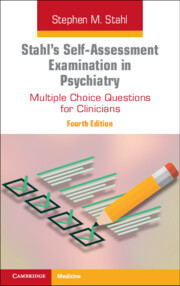Book contents
- Stahl’s Self-Assessment Examination in Psychiatry
- Stahl’s Self-Assessment Examination in Psychiatry
- Copyright page
- Contents
- Introduction/Preface
- CME/CE Information
- 1 ADHD and Its Treatment
- 2 Anxiety/Stress Disorders and Their Treatment
- 3 Basic Neuroscience and Pharmacological Concepts
- 4 Bipolar Disorder and Its Treatment
- 5 Chronic Neuropathic Pain and Its Treatment
- 6 Dementia and Its Treatment
- 7 Psychosis and Its Treatment
- 8 Sleep/Wake Disorders and Their Treatment
- 9 Substance Use/Impulsive-Compulsive Disorders and Their Treatment
- 10 Unipolar Depression and Its Treatment
- Index
- References
6 - Dementia and Its Treatment
Published online by Cambridge University Press: 22 July 2022
- Stahl’s Self-Assessment Examination in Psychiatry
- Stahl’s Self-Assessment Examination in Psychiatry
- Copyright page
- Contents
- Introduction/Preface
- CME/CE Information
- 1 ADHD and Its Treatment
- 2 Anxiety/Stress Disorders and Their Treatment
- 3 Basic Neuroscience and Pharmacological Concepts
- 4 Bipolar Disorder and Its Treatment
- 5 Chronic Neuropathic Pain and Its Treatment
- 6 Dementia and Its Treatment
- 7 Psychosis and Its Treatment
- 8 Sleep/Wake Disorders and Their Treatment
- 9 Substance Use/Impulsive-Compulsive Disorders and Their Treatment
- 10 Unipolar Depression and Its Treatment
- Index
- References
Summary
Harold, a 74-year-old patient, is brought to your office by his daughter, who reports that her father has been exhibiting several concerning symptoms over the past year. Comprehensive questioning reveals that his symptoms are: trouble remembering familiar things, such as telephone numbers commonly dialed; not recognizing some close family members who visit often; and difficulty performing writing tasks. The patient’s motor function appears to be unaffected. Although not definitive, these symptoms are most likely indicative of which type of dementia?
- Type
- Chapter
- Information
- Stahl's Self-Assessment Examination in PsychiatryMultiple Choice Questions for Clinicians, pp. 179 - 206Publisher: Cambridge University PressPrint publication year: 2022



